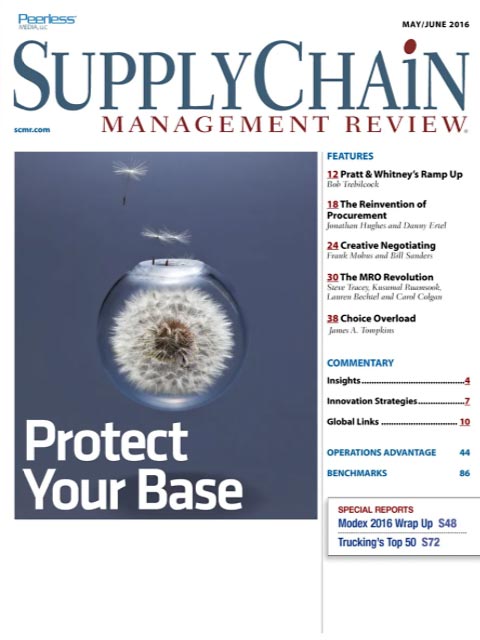Sorry, but your login has failed. Please recheck your login information and resubmit. If your subscription has expired, renew here.
May-June 2016
The procurement function is at an inflection point.” So begins “The reinvention of procurement," an article by Jonathan Hughes and Danny Ertel, partners at the Boston-based consulting firm Vantage Partners. The authors argue that while many leading companies have transformed their procurement organizations into a linchpin of their enterprise strategy, far too many others remain trapped by procurement models that are out of date in today’s fastpaced economy, where the acquisition of innovation, collaboration, services and solutions is more important than transactions based on the lowest cost per unit. Reinvention is a fitting theme for… Browse this issue archive.Need Help? Contact customer service 847-559-7581 More options
I recently got two calls from trade publication writers interested in how warehouse (and perhaps other supply chain execution) managers might get involved in their company’s sales and operations (S&OP) processes. It seems S&OP teams often have little to do with execution/operations managers regarding synchronizing execution to plans. While some software companies purport to do this—perhaps from a computer systems perspective—the business processes of supply chain planning (e.g., S&OP) and execution ought to be integrated.
These managers often don’t need to be at S&OP meetings because supply chain planners typically represent their interests. However, S&OP supply plans ought to be communicated to operations managers because they need them to drive their own short- and long-term planning efforts. This is the way to tie business strategy to operations (e.g., strategy executed daily on the manufacturing plant floor and in the warehouse).
Synchronizing operations with planning is strategic. Operational managers don’t necessarily need to attend S&OP meetings because these meetings are focused on more aggregated business views over longer planning horizons than the managers are interested in. SO&P plans that typically focus on six months to 18 months out, and on a weekly or monthly basis, don’t provide operations managers with enough detail about products, customers and geographies.
 |
This complete article is available to subscribers
only. Click on Log In Now at the top of this article for full access. Or, Start your PLUS+ subscription for instant access. |
SC
MR
Sorry, but your login has failed. Please recheck your login information and resubmit. If your subscription has expired, renew here.
May-June 2016
The procurement function is at an inflection point.” So begins “The reinvention of procurement," an article by Jonathan Hughes and Danny Ertel, partners at the Boston-based consulting firm Vantage Partners.… Browse this issue archive. Access your online digital edition. Download a PDF file of the May-June 2016 issue. |
Download Article PDF |
I recently got two calls from trade publication writers interested in how warehouse (and perhaps other supply chain execution) managers might get involved in their company's sales and operations (S&OP) processes. It seems S&OP teams often have little to do with execution/operations managers regarding synchronizing execution to plans. While some software companies purport to do this—perhaps from a computer systems perspective—the business processes of supply chain planning (e.g., S&OP) and execution ought to be integrated.
These managers often don't need to be at S&OP meetings because supply chain planners typically represent their interests. However, S&OP supply plans ought to be communicated to operations managers because they need them to drive their own short- and long-term planning efforts. This is the way to tie business strategy to operations (e.g., strategy executed daily on the manufacturing plant floor and in the warehouse).
Synchronizing operations with planning is strategic. Operational managers don't necessarily need to attend S&OP meetings because these meetings are focused on more aggregated business views over longer planning horizons than the managers are interested in. SO&P plans that typically focus on six months to 18 months out, and on a weekly or monthly basis, don't provide operations managers with enough detail about products, customers and geographies.
 |
SUBSCRIBERS: Click here to download PDF of the full article. |
SC
MR

Latest Supply Chain News
- Tariffs, taxes and trade: The impact of Trump’s reelection on the supply chain
- How to improve demand forecasts for new product families
- Services sector sees growth in October, reports ISM
- Balanced supply chain management Part 4: The key—leading beyond the silo
- Managing inbound freight: What has changed in two decades?
- More News
Latest Podcast

 Explore
Explore
Latest Supply Chain News
- Tariffs, taxes and trade: The impact of Trump’s reelection on the supply chain
- How to improve demand forecasts for new product families
- Services sector sees growth in October, reports ISM
- Balanced supply chain management Part 4: The key—leading beyond the silo
- Managing inbound freight: What has changed in two decades?
- Inbound freight: Often a missed opportunity
- More latest news
Latest Resources

Subscribe

Supply Chain Management Review delivers the best industry content.

Editors’ Picks





